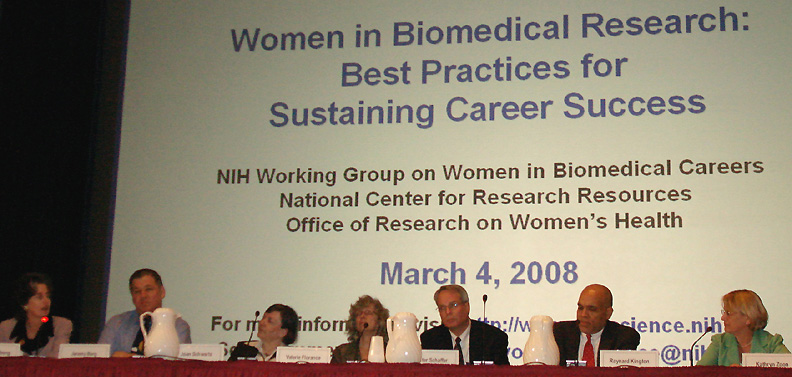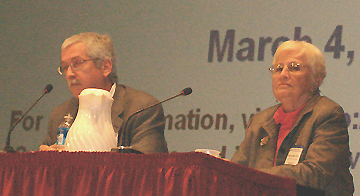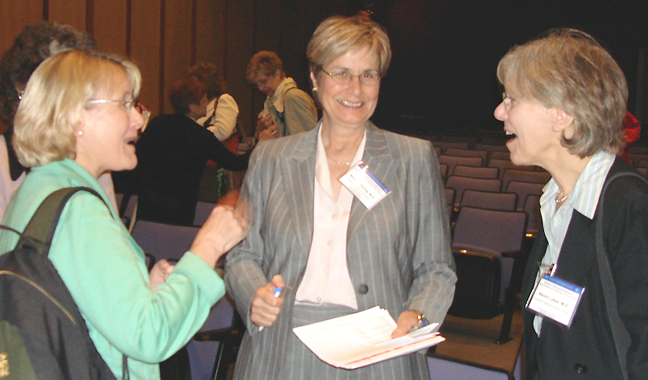| T
H E N I H C A T A L Y
S T |
M A R C H – A
P R I L
2008 |
|
BIAS
AGAINST WOMEN IN
SCIENCE:
IT'S STILL
THERE, AND IT'S
GOT TO GO
|
by
Fran Pollner
|
 |
Agents of Change:
Discussing NIH initiatives to correct gender imbalances are (left to
right) Joan Goldberg, executive director, American Society for Cell
Biology; Jeremy Berg,
NIGMS director; Joan Schwartz, assistant director, OIR; Valerie Florance,
deputy director for extramural programs, NLM; Walter Schaffer, senior
scientific advisor for extramural research; Raynard Kington, NIH deputy
director; and panel chair Kathryn
Zoon, director of intramural research, NIAID
|
If
there is such a thing today as a post-feminist world, it’s not to be found
just yet in much of the biomedical research arena, where various obstacles thwart
the advancement of women scientists to commanding positions, such as department
head at a research university or lab chief at NIH.
But
rigorous documentation of attrition rates for women beyond the postdoctoral
level has set the stage for designing and implementing systematic remedies,
and large numbers of people in the field are determined to turn things around.
"This
is not something we ought to be doing because it’s nice to do. It’s
something we have to do" because the future of biomedical research depends
on it, said NCRR Director Barbara
Alving, opening a daylong conference here on "Best Practices for Sustaining
Career Success" for women in biomedical research.
The
military biomedical research sector, as well as successful businesses, "recognized
this long ago" and have developed "innovative practices" to attract
and retain women at the highest levels, Alving said, presaging several talks
on the day’s agenda.
Framing
the Issues: Numbers Talk
Women
have become 50 percent of medical school applicants and graduates and they are
46 percent of assistant deans and 33 percent of associate deans—but only
12 percent of deans of U.S. medical schools, said keynoter Nancy Andrews, dean
of the Duke University School of Medicine, Durham, N.C., who upon her appointment
published a piece in the November 2007 issue of the New England Journal of
Medicine entitled "Climbing
Through Medicine’s Glass Ceiling."
Deans,
Andrews observed, emerge not from the pool of associate deans but from department
chairs, a far more elusive inner circle for women, who hold 8.5 percent of these
positions. Although junior women tend to downplay gender bias as a major problem
for women in academic medicine, citing work-family balance as the greatest challenge,
marginalization rooted in gender bias is felt increasingly by senior women as
they move up in the ranks, she said.
Andrews
advocated relentless "nagging" to change the facts on the ground—like
upping the numbers of women on speakers’ lists and search committees and
removing administrators with poor track records in hiring and retaining women.
 |
Data Miners:
Timothy Ley and Phoebe Leboy |
More
numbers—documenting just how few women do move up in the ranks—were
offered by Timothy Ley, associate director of basic science and professor of
medicine at the Washington University Medical School in St. Louis, and Phoebe
Leboy, president of the Association for Women in Science and professor of biochemistry
at the University of Pennsylvania School of Dental Medicine in Philadelphia.
At
each step on the NIH grant-funding ladder, fewer women apply–and not because
they are less successful at being selected, Ley reported. There is little difference
among the three groups of degree-holders—Ph.D, M.D., and M.D.-Ph.D.—with
the most dramatic falloff occuring at the late postdoctoral stage between the
K23 and KO8 levels, when about half of the women applicants are lost; when the
first RO1 application level is reached, the ratio of male to female applicants
is 2–3:1, he said. "Among those who do apply, the success rates are
identical . . . but women are leaving the academic medical career path at double
and triple the rate of men." Ley observed that that path "was created
by men for men."
"The
objective evidence," Leboy concurred, "is that women score very well
on grant applications." In 2006, there were more women than men in the
top 10 percent fundable NIH grant applications, she said, but the other side
of that story is that there are fewer grants per PI among women, fewer dollars
per grant awarded women, a lower reapplication success rate for women, and a
nearly complete absence of women on the "really big and increasingly popular
center grants." The last item, she noted, reflects the nearly exclusive
selection of men as PIs by the participating institutions.
Tracking
the progress of women with Ph.D.s in biochemistry, molecular biology, cell biology,
developmental biology, and
neuroscience at academic health centers and research universities, Leboy reported
the results of a survey of 58 institutions that in November 2007 had advertised
faculty positions in these fields. Far fewer women applied than would be expected
based on the percentage of women in the potential Ph.D. applicant pool.
For
instance, although women hold 43 percent of Ph.D.s in biochemistry, they were
only 17 percent of applicants for junior faculty positions in biochemistry departments;
the statistics for cell and developmental biology were closer to 30 percent
but well under the expected 48 and 52 percent. "Women are avoiding tenure-track
faculty jobs," Leboy said, noting that this study did not address how many
women were actually hired.
She noted that the "proportion of tenure-track and tenured women has reached
a plateau of less than 60 percent of expectations and is now declining."
These data, she said, support the finding that women are more likely to opt
out at the point of transitioning beyond the postdoc stage, reported in the
November 2007 issue of EMBO Reports.*
The
question of why, however, remains, she added, noting that although the EMBO
report suggests that women have less confidence, the "chilly climate"
for women in academia may go further in explaining why "smart young women"
are disinclined to pursue biomedical careers there. There are no data, she added,
on how many of these women enter the private workforce.
In
all arenas, it was mentioned throughout the conference, there are next to no
data on minority women in science.
 |
| Camaraderie:
(left to right) Kathryn Zoon, NIAID scientific director; Barbara Alving,
NCRR director and conference chair, and Naomi Luban, chief of laboratory
medicine, Department of Pediatrics, Children’s National Medical Center,
Washington |
Climate
Change
Early
last year, in response to a National Academies report on bias and barriers facing
women in academic science and engineering, NIH Director Elias
Zerhouni established the NIH Working Group on Women in Biomedical Careers.
This conference was the objective of one of the group’s 11 subcommittees.
NIH
Deputy Director Raynard Kington, chair of the subcommittee on research on the
efficacy of programs to reduce gender bias, observed that with the will to change,
things can happen quickly, as was the case with the Director’s Pioneer
Awards, part of the NIH Roadmap: None of the first-year awardees were women,
but
46 percent of the second-year cohort were. The change was effected not by targeting
women for awards but by making the process fairer, he said.
His
subcommittee is canvassing programs across the country aimed at "transforming
the culture" and has found that most of them are small, under five years
old, and unevaluated for impact. NIGMS, he said, has issued an RFA to study
interventions to promote biomedical research careers and their effectiveness.
Addressing
the climate at home, Joan Schwartz, assistant
director, OIR, and a member of several subcommittees aimed at recruiting, retaining,
and advancing women at NIH, outlined some of the programs under consideration
or underway:
 expanding access to childcare both on and off campus
expanding access to childcare both on and off campus
 providing a tenure-track investigator or PI with a temporary lab manager during
times of needed extended leave
providing a tenure-track investigator or PI with a temporary lab manager during
times of needed extended leave
 recruitment of dual-career couples, facilitated through a regional consortium,
of which NIH is a founding member
recruitment of dual-career couples, facilitated through a regional consortium,
of which NIH is a founding member
 encouraging teleworking
encouraging teleworking
 creation of a trans-NIH mentoring committee; training PIs in mentoring skills
and senior investigators, postdocs, and graduate students in leadership skills
creation of a trans-NIH mentoring committee; training PIs in mentoring skills
and senior investigators, postdocs, and graduate students in leadership skills
 conducting focus groups among NIH women to learn how to promote taking the first
step beyond the postdoc level
conducting focus groups among NIH women to learn how to promote taking the first
step beyond the postdoc level
Asked
for some statistics on women lab chiefs at NIH, Schwartz noted that the percent
has increased over the last 10 years—from 4 to 16 percent.
She
issued an oft-repeated invitation that attendees "please send in any thoughts
you have." To do so, write to <womeninscience@nih.gov>.

___________________________________________________________
*"Falling
Off the Academic Bandwagon," by members of the NIH Postdoctoral Fellows
Subcommittee of the Second Task Force on the Status of NIH Intramural Women
Scientists
| How
Does Industry Do It? |
Anticipating
a serious shortage of skilled employees, private sector companies in the
late 1980s and early 1990s decided that hiring more women—and, especially,
retaining them—would be a solution and key to future success, according
to Asif Dhar, biomedical informatics practice leader at Deloitte Consulting
in McLean, Va., and Jo Ellen Helmer, a partner at Ernst & Young LLP
in Chicago.
Deloitte started
the Women’s Initiative in 1993, focusing on two main aspects: providing
a network and mentorship for women throughout their careers and allowing
for a nonlinear progression of careers. Employees can customize and adjust
the pace, workload, location schedule, and role they would like to play
in the company according to the stage of life they are in.
Flexibility
is also the key in keeping women in the workforce at Ernst & Young.
Flexible work hours, mentoring, and networking are essential, and such
items as longer maternity leave have greatly added to the satisfaction
of women, Helmer said. In fact, the models originally developed for women
have been adopted for the workforce in general and have proved to increase
overall productivity.
Both speakers
emphasized the importance of measuring the success of the program and
making senior staff accountable. At Ernst & Young, it is impossible
to reach maximum points (and therefore maximum pay bonuses) if the "inclusiveness"
goals have not been achieved.
—Christiane
Jost
|
Return
to Table of Contents


